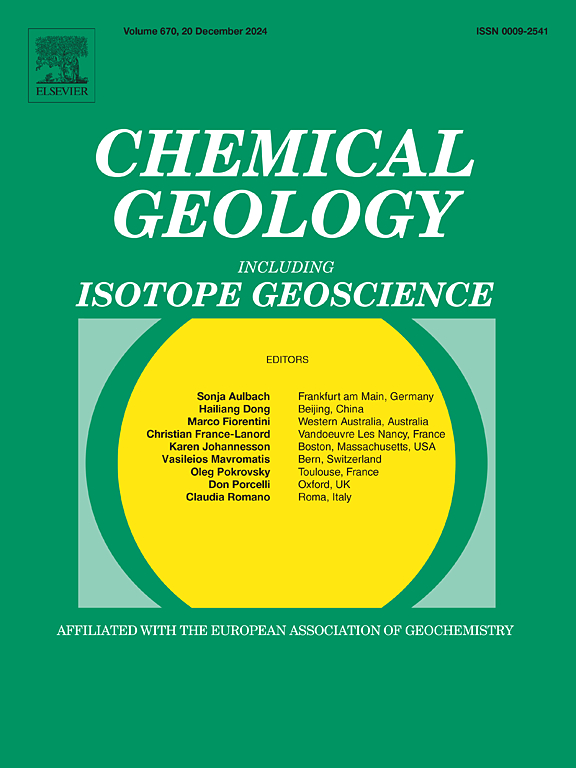Promises and pitfalls of source terrane prediction from inclusions in detrital zircon
IF 3.6
2区 地球科学
Q1 GEOCHEMISTRY & GEOPHYSICS
引用次数: 0
Abstract
Understanding the relationship between the assemblage of mineral inclusions trapped by an igneous zircon suite and the composition of the host magma is complicated by processes that preclude simple relationships between, for example, the relative proportions of modal mineral inclusions (e.g., quartz, alkali feldspar, and plagioclase; QAP) and the degree of magma differentiation. However, apatite and ferromagnesian inclusion abundances can be approximately related to the SiO2 content in some magmas, potentially allowing for broad inferences of source rock composition from detrital zircon mineral inclusion suites. This study presents mineral inclusion assemblages in igneous zircon from a wide range of magma compositions, tectono-magmatic settings, and geographic locations to better determine the correlation between major inclusion phases and source rock chemistry. We find that the relationship between apatite and whole rock SiO2 is strongly dependent on the aluminosity (as shown by A/CNK) of the source rock, with peraluminous and metaluminous rocks showing opposite trends. For inclusion assemblages containing less than about 30–40 % apatite, discrimination of highly silicic peraluminous from mafic-intermediate metaluminous granitoid sources is possible. Metaluminous samples display a broad increase in whole rock phosphate content with increasing apatite inclusion abundance, potentially allowing estimation of lower limits on protolith phosphate abundance. The ratio of ferromagnesian to late-crystallizing inclusions exceeds 0.5 mostly for mafic-intermediate samples, with some exceptions. Inclusion phases concentrating highly incompatible trace elements exceed 5 % of the inclusion suite only in highly silicic (>70 % SiO2) granites. However, there is no discernable relationship between QAP and whole rock chemistry, with inclusion QAP from compositionally diverse magmas clustering in a similar region of the QAP diagram. Application of these observations to several first-generation sediments derived from granitoid terranes suggests that apatite abundance, the ratio of ferromagnesian to late-crystallizing silicate inclusions, and trace elements can help select between peraluminous vs. metaluminous sources and help to distinguish mafic-intermediate from highly silicic source rocks. This could have wide applicability to using the detrital zircon record to infer petrogenetic provenance.
碎屑锆石包裹体预测源地的前景与缺陷
理解火成岩锆石套捕获的矿物包裹体组合与寄主岩浆组成之间的关系是复杂的,因为一些过程排除了以下之间的简单关系:例如,模态矿物包裹体(如石英、碱长石和斜长石)的相对比例;QAP)和岩浆分异程度。然而,磷灰石和镁铁包裹体丰度可以近似地与某些岩浆中的SiO2含量相关,从而可能从碎屑锆石矿物包裹体套件中广泛推断烃源岩组成。本研究从岩浆组成、构造-岩浆环境和地理位置等方面对火成岩锆石中的矿物包裹体组合进行了研究,以更好地确定主要包裹体相与烃源岩化学的相关性。磷灰石与全岩SiO2的关系强烈依赖于烃源岩的铝质度(A/CNK),过铝质岩与铝质岩呈现相反的趋势。对于磷灰石含量低于约30 - 40%的包裹体组合,可以区分高硅过铝和镁质-中间铝质花岗岩源。随着磷灰石包裹体丰度的增加,铝质样品显示整个岩石磷酸盐含量的广泛增加,这可能允许估计原岩磷酸盐丰度的下限。镁铁质与晚结晶夹杂物的比值大于0.5,大部分镁铁质中间样品除外。只有在高硅(> 70% SiO2)花岗岩中,富集高度不相容微量元素的包裹体相才超过包裹体组的5%。然而,QAP与整个岩石化学之间没有明显的关系,来自不同成分岩浆的包裹体QAP聚集在QAP图的相似区域。将这些观察结果应用于花岗岩类地体的第一代沉积物中,表明磷灰石丰度、镁铁与晚结晶硅酸盐包裹体的比例以及微量元素可以帮助选择过铝质与铝质来源,并有助于区分镁质中间体与高硅质来源岩。这对于利用碎屑锆石记录推断成岩物源具有广泛的适用性。
本文章由计算机程序翻译,如有差异,请以英文原文为准。
求助全文
约1分钟内获得全文
求助全文
来源期刊

Chemical Geology
地学-地球化学与地球物理
CiteScore
7.20
自引率
10.30%
发文量
374
审稿时长
3.6 months
期刊介绍:
Chemical Geology is an international journal that publishes original research papers on isotopic and elemental geochemistry, geochronology and cosmochemistry.
The Journal focuses on chemical processes in igneous, metamorphic, and sedimentary petrology, low- and high-temperature aqueous solutions, biogeochemistry, the environment and cosmochemistry.
Papers that are field, experimentally, or computationally based are appropriate if they are of broad international interest. The Journal generally does not publish papers that are primarily of regional or local interest, or which are primarily focused on remediation and applied geochemistry.
The Journal also welcomes innovative papers dealing with significant analytical advances that are of wide interest in the community and extend significantly beyond the scope of what would be included in the methods section of a standard research paper.
 求助内容:
求助内容: 应助结果提醒方式:
应助结果提醒方式:


